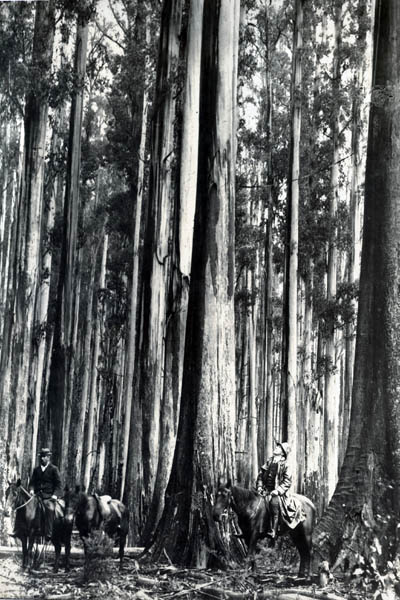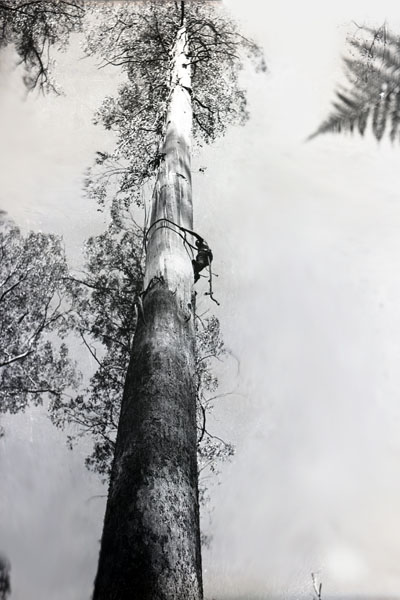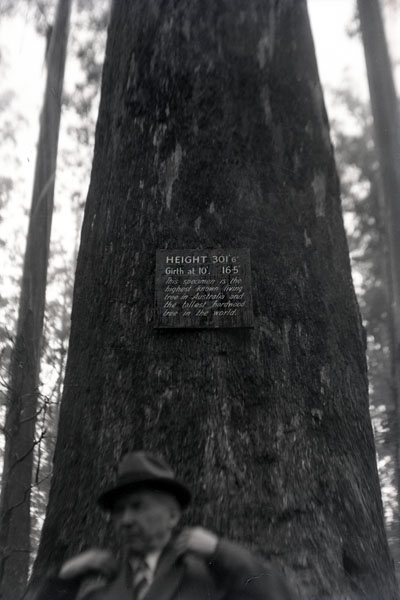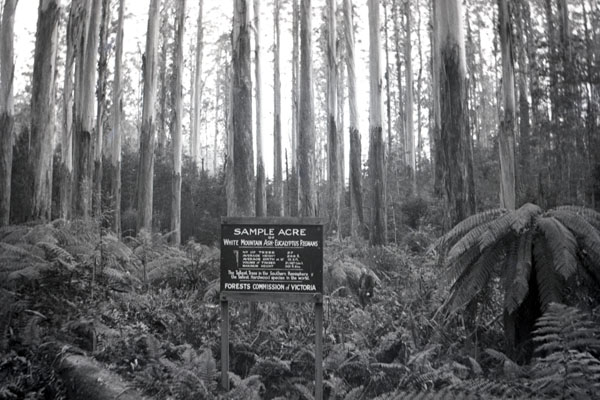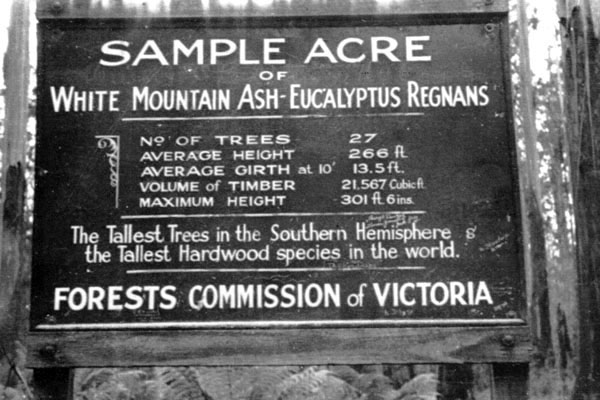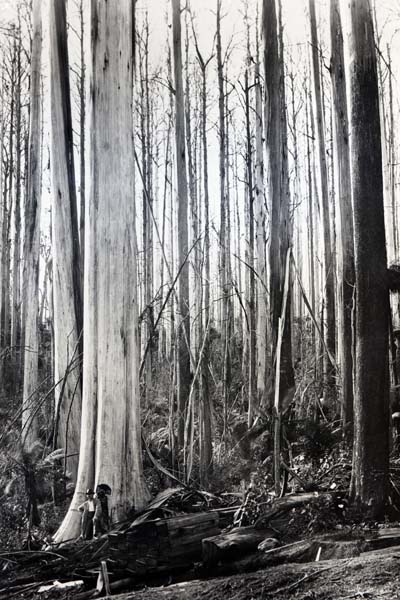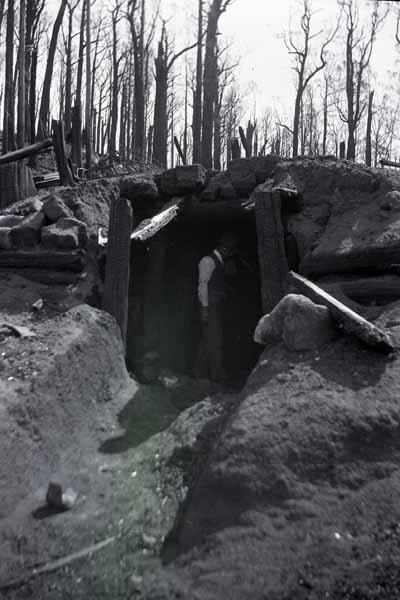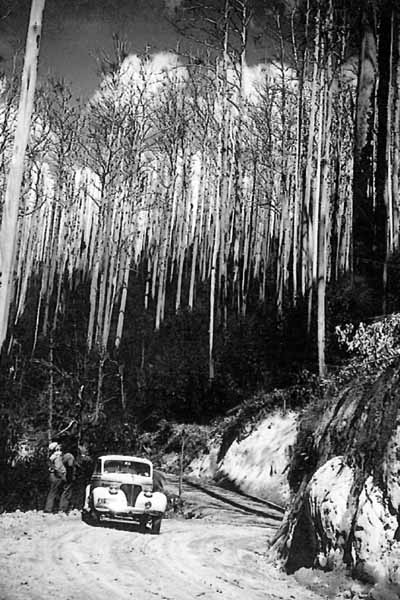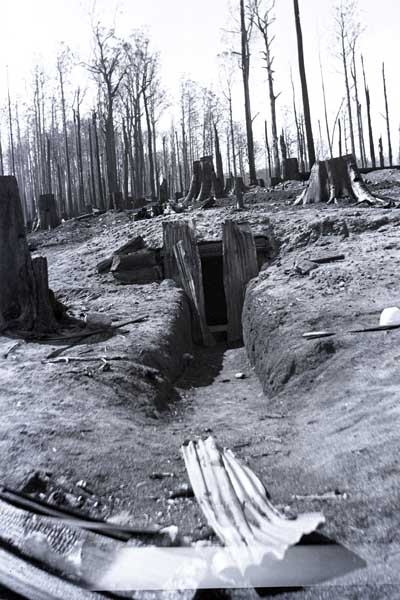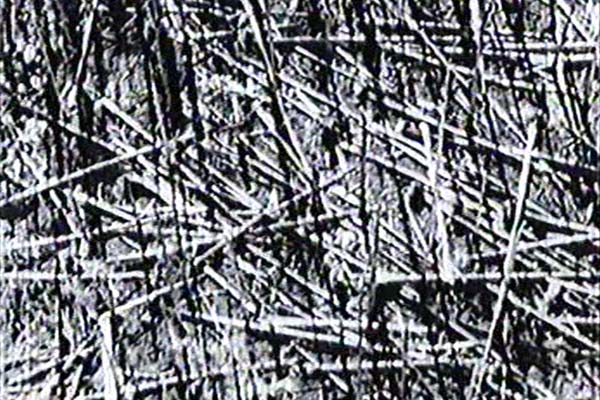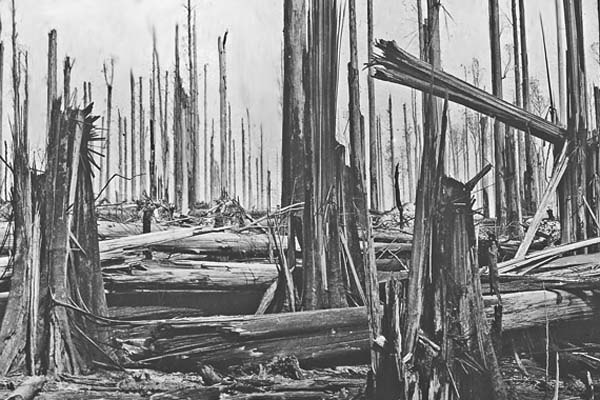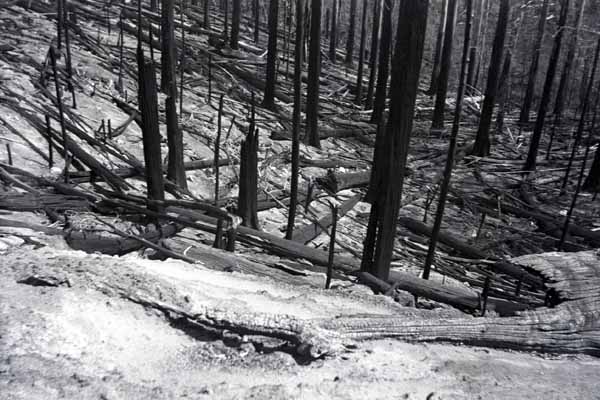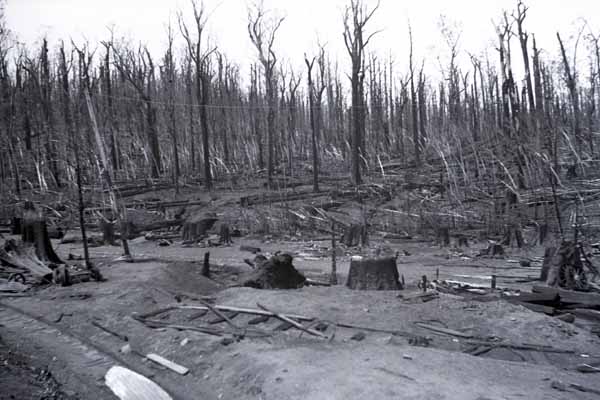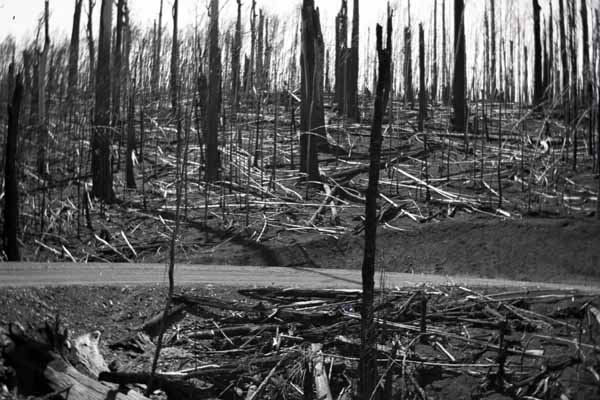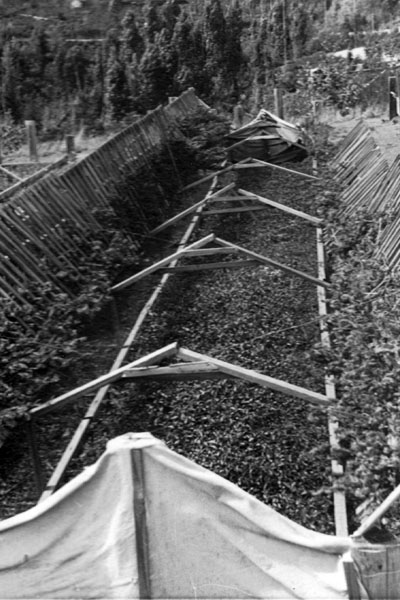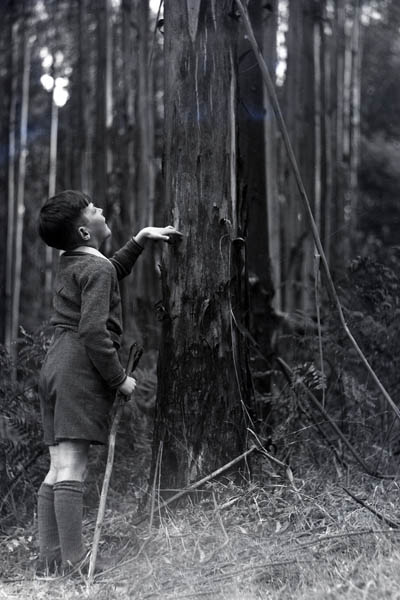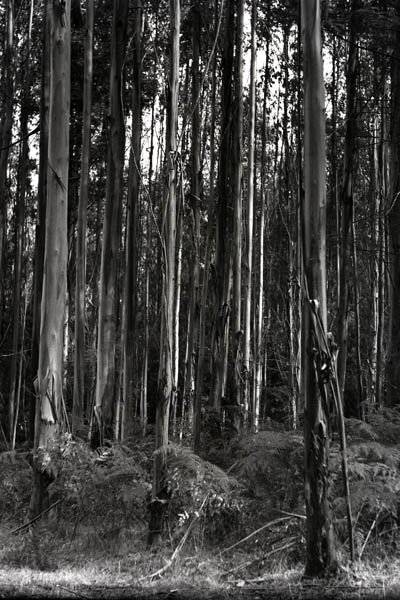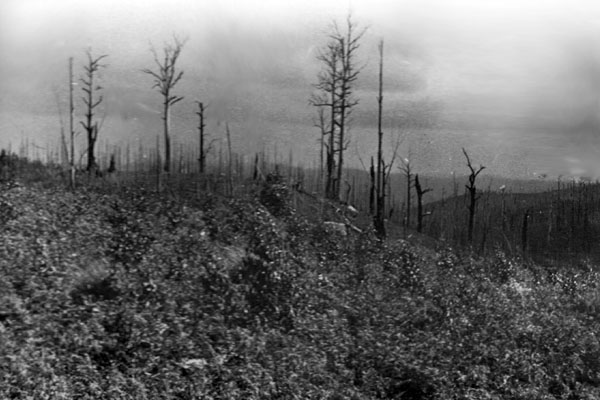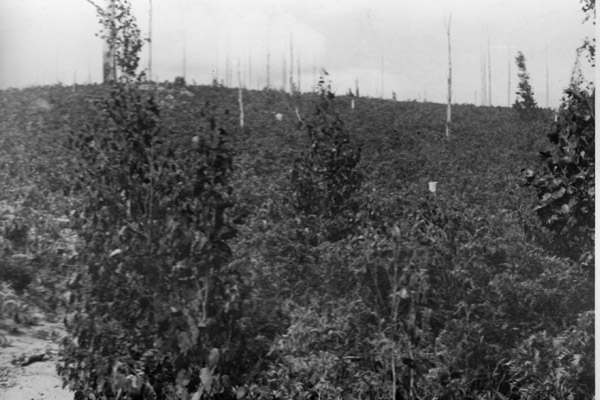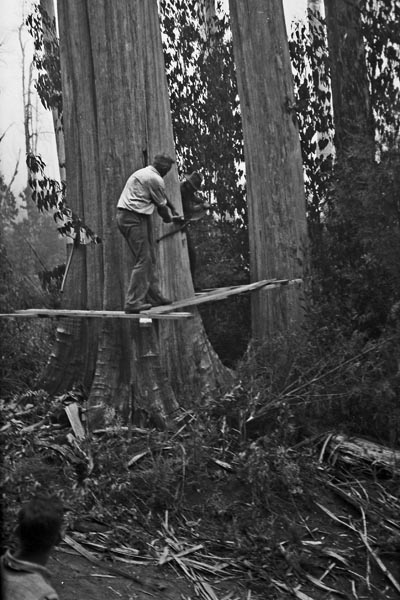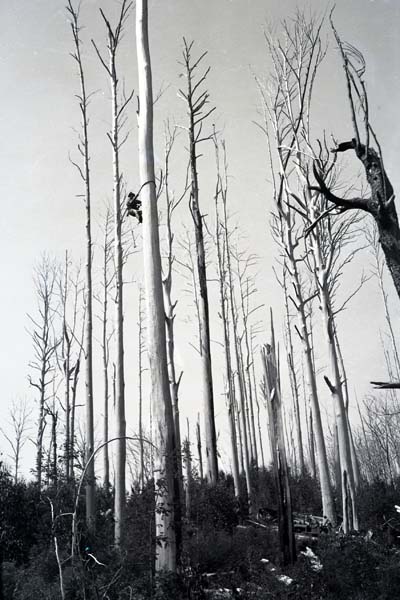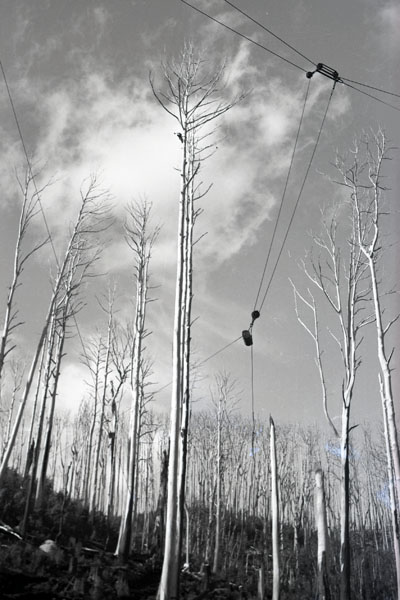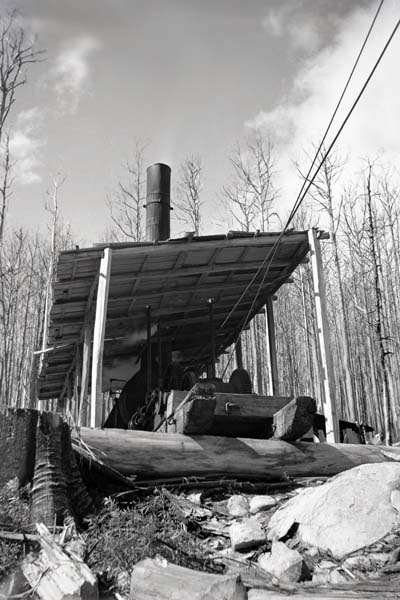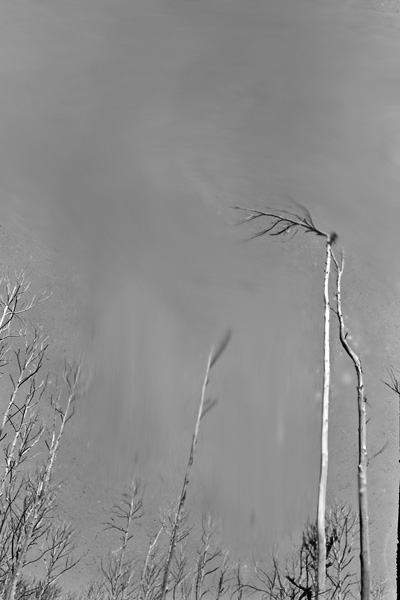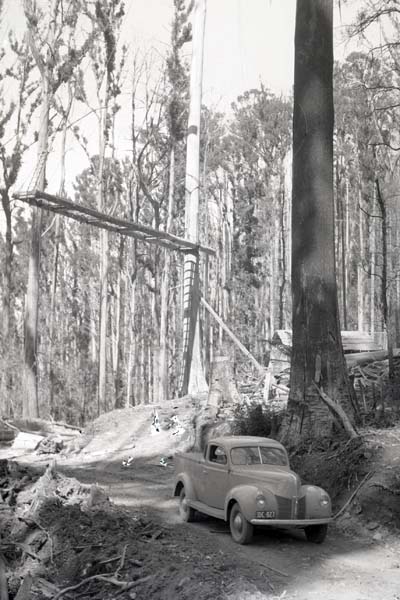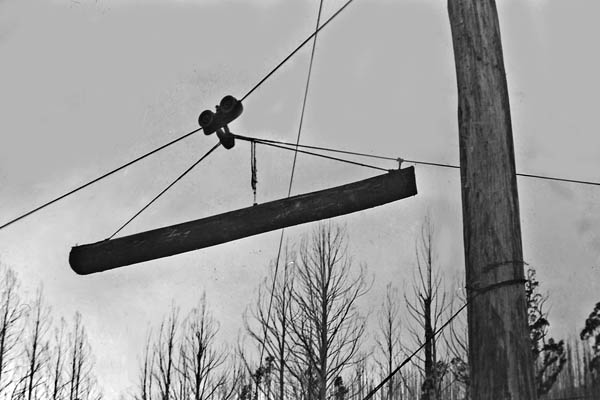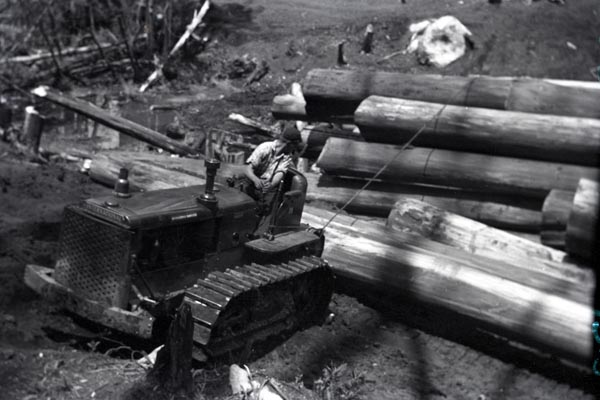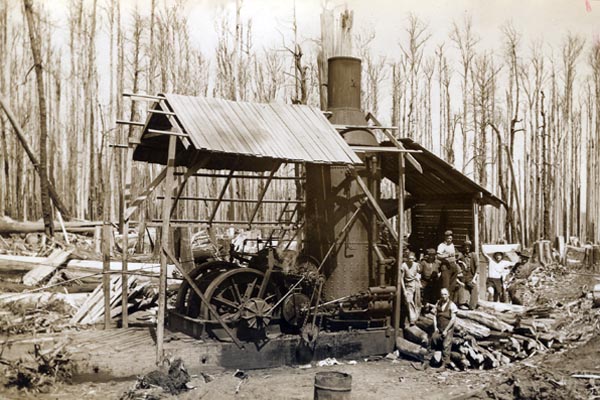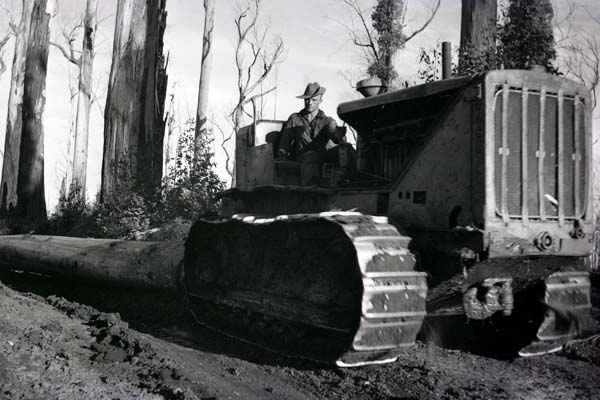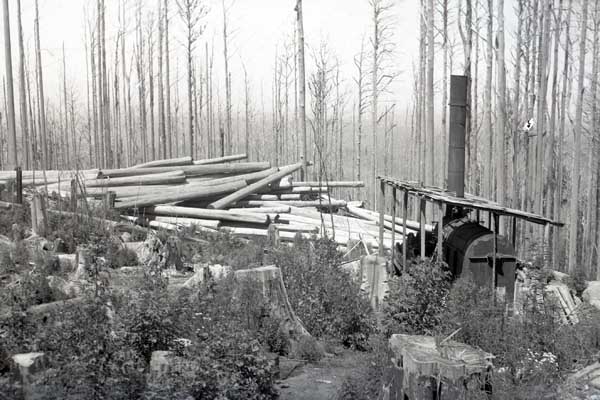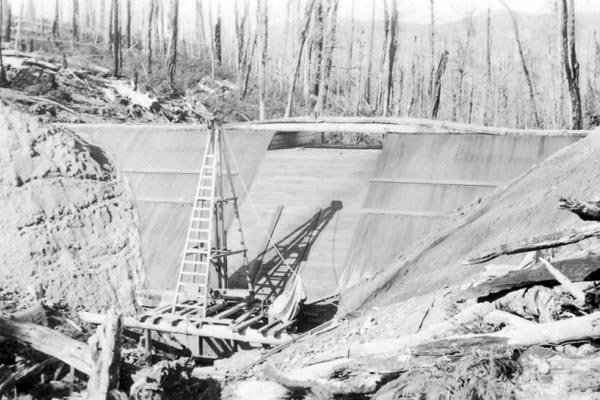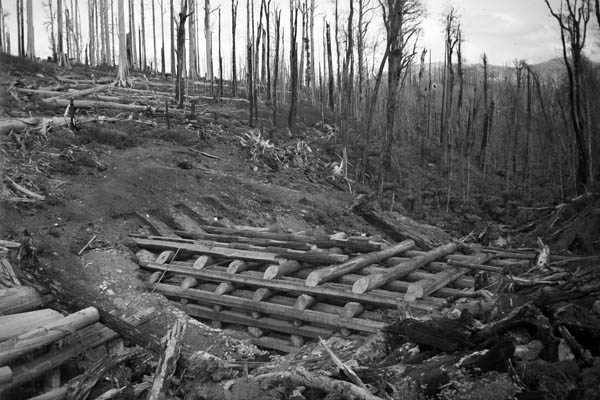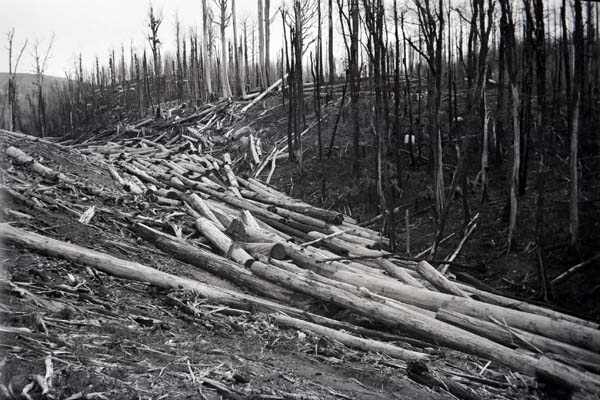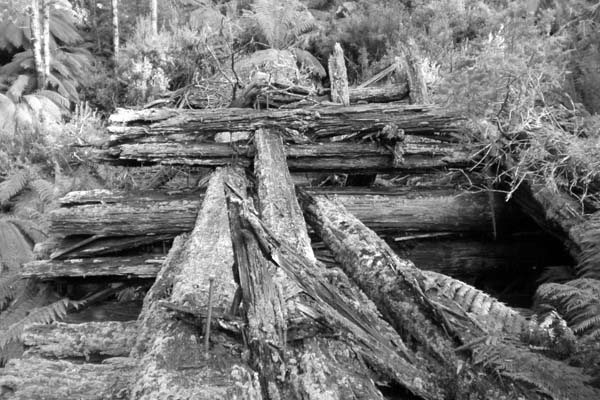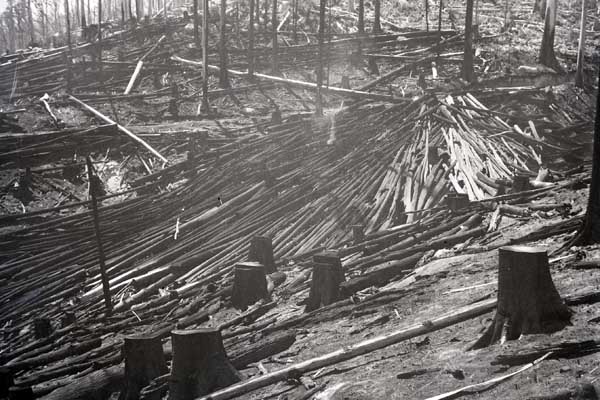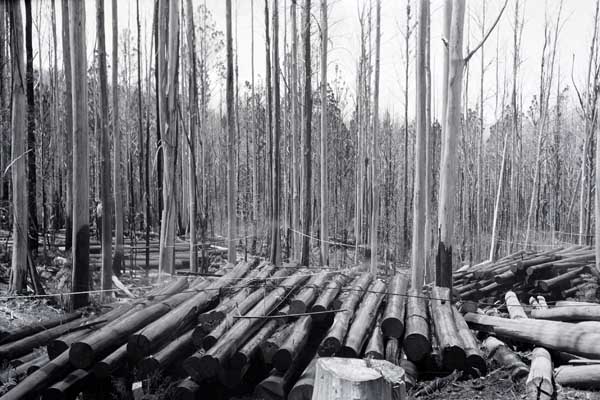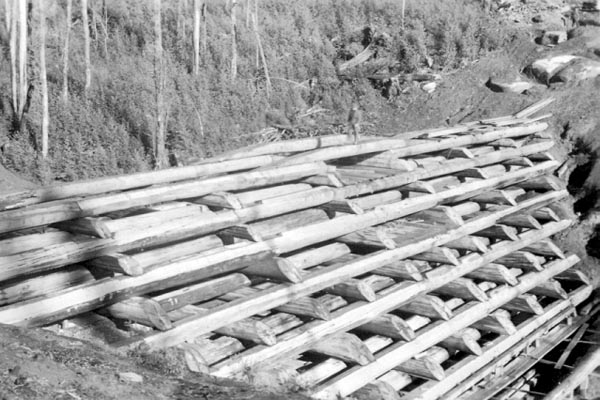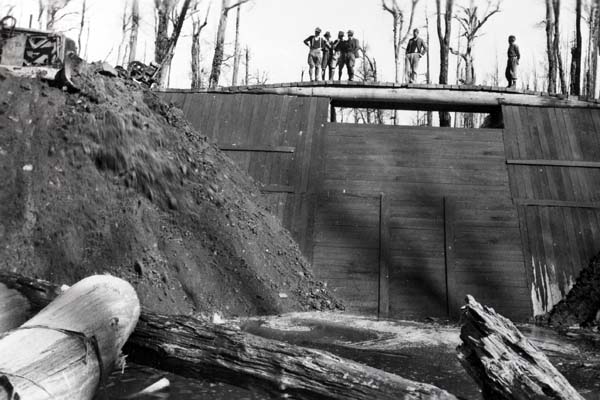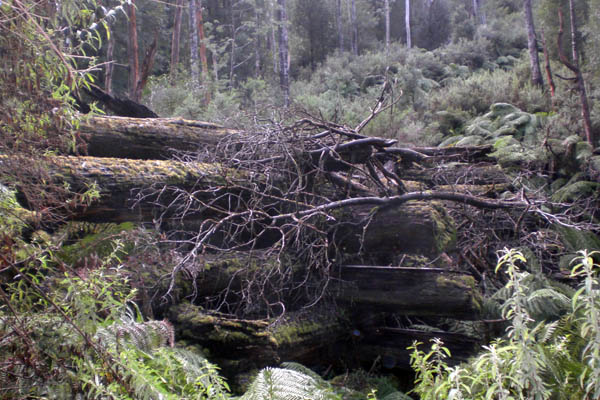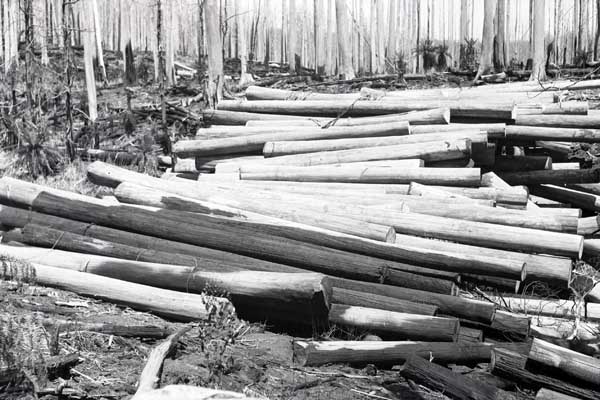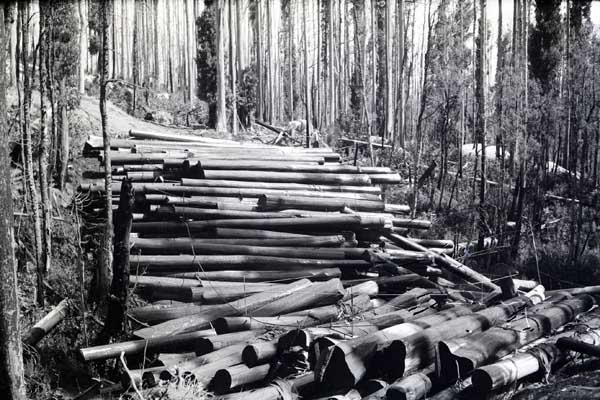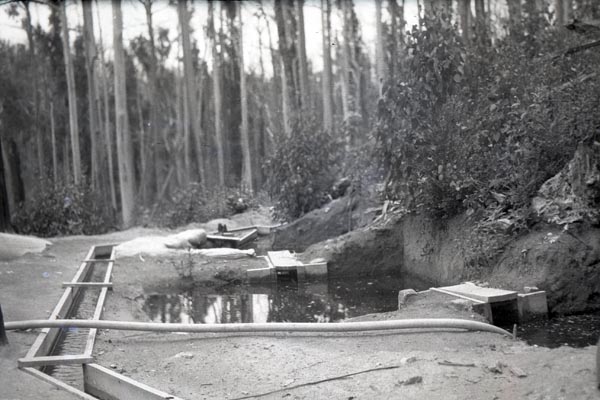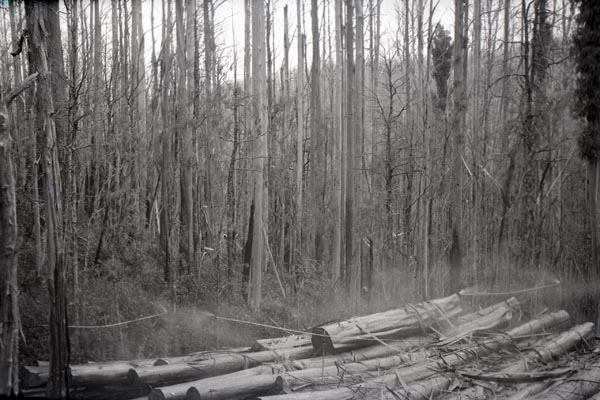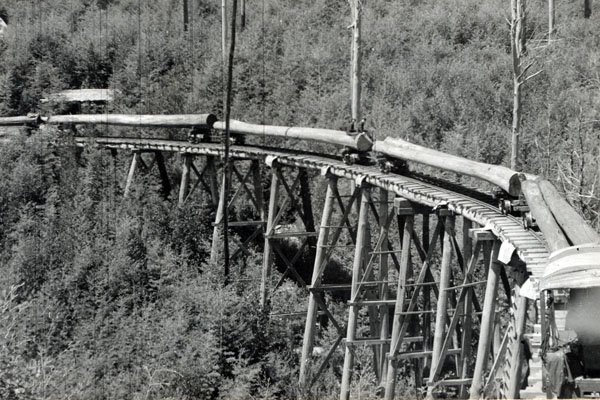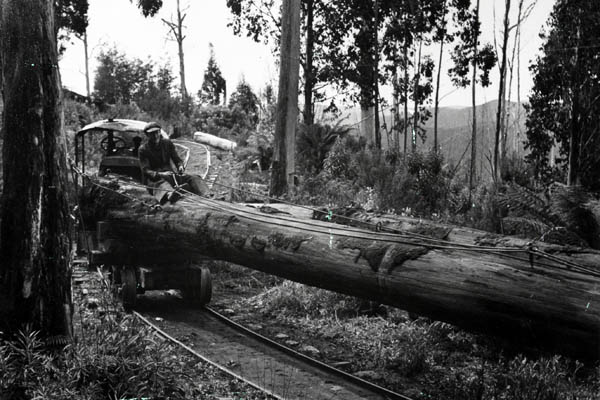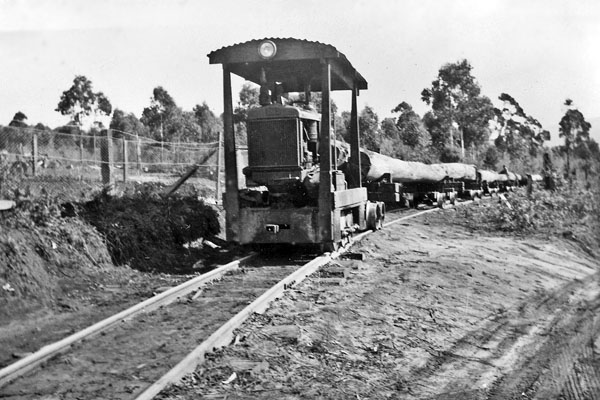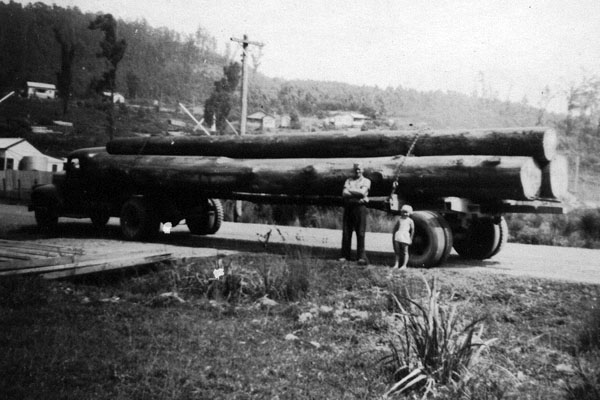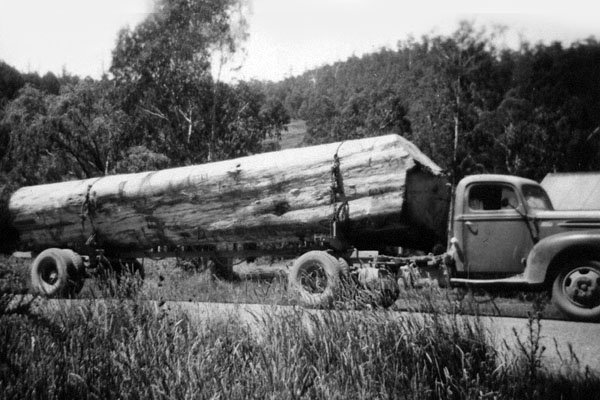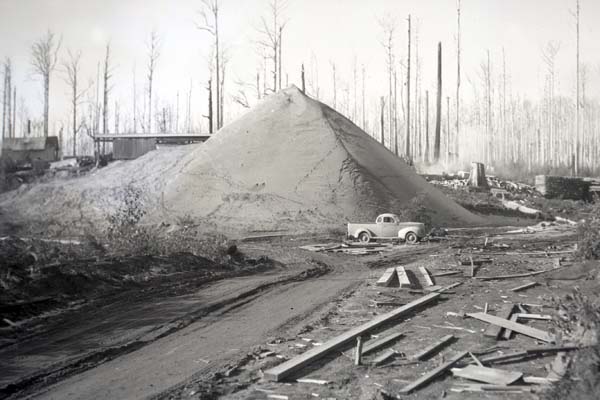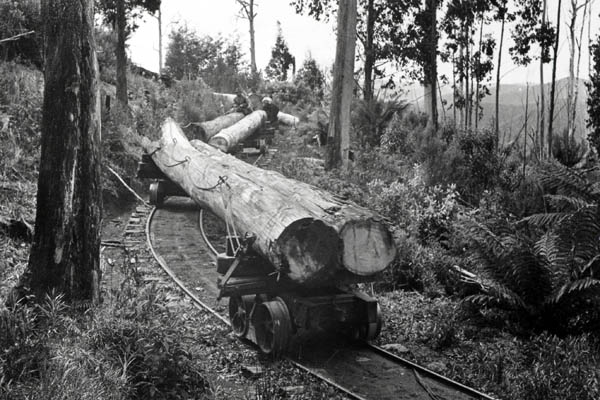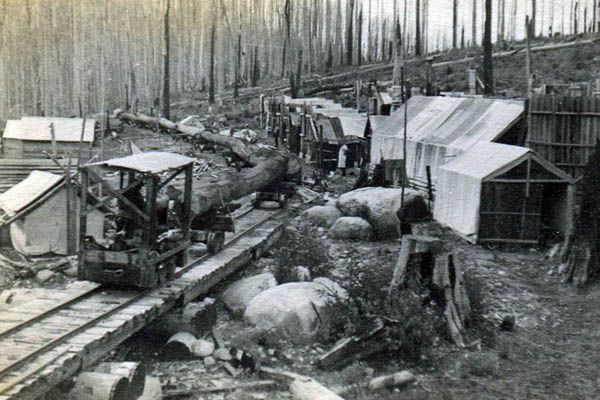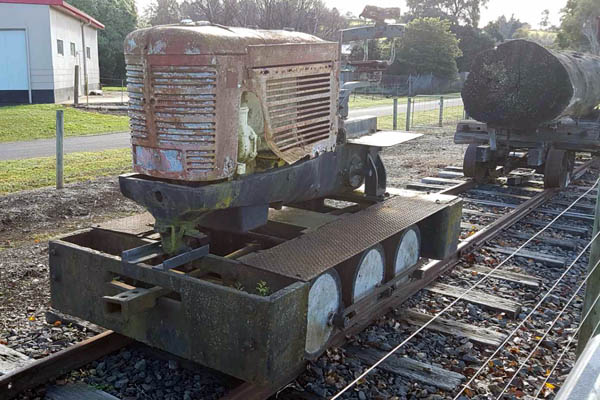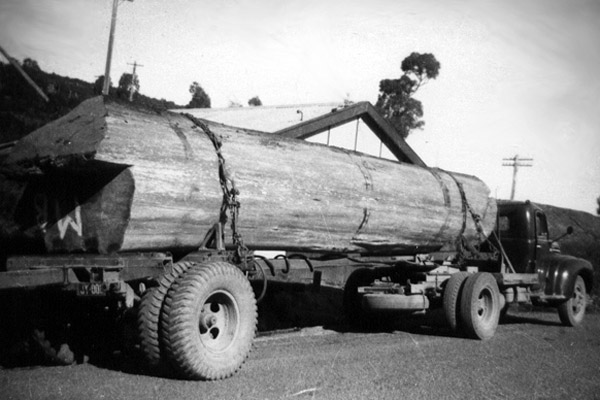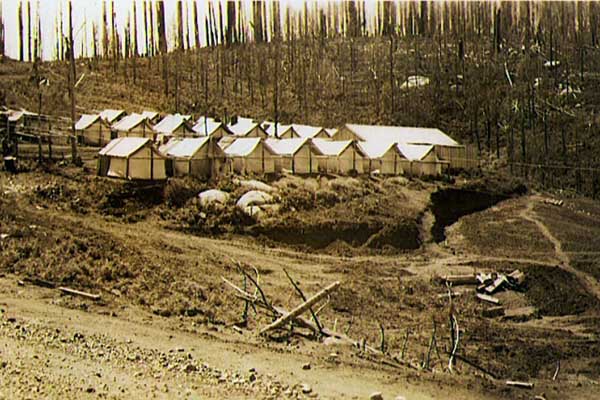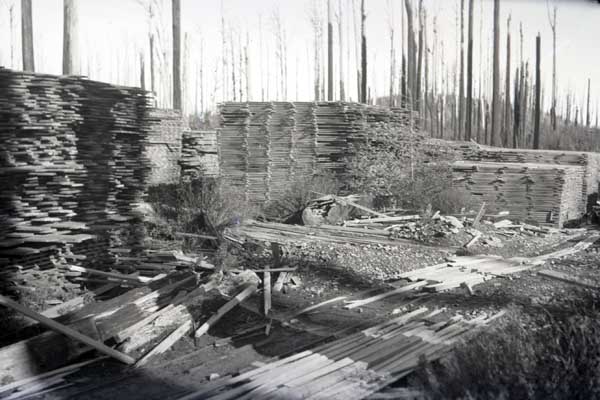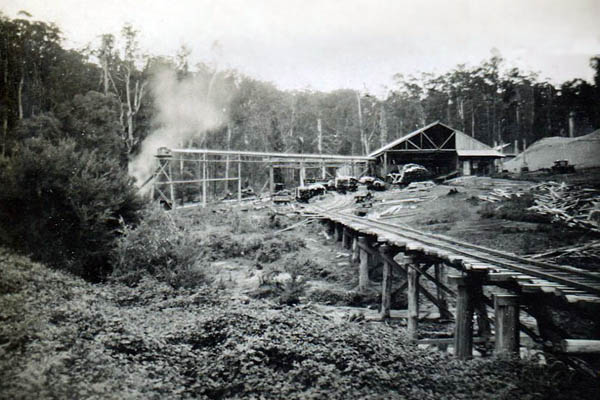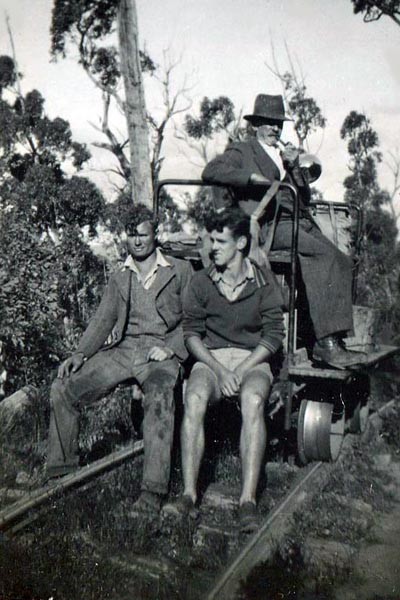Post 1939 Recovery & Salvage
"The salvage operation of the 1939 fire-killed timber ... was a tremendous operation. I was a member of the original salvage committee but I later became personally involved with the utilisation of small logs which were fire-killed and which were used to replace the hemlock flitches which had provided the bulk of the timber for the manufacture of cases prior to World War II. Enormous shipments of hemlock used to arrive here every month for case manufacture, but were cut off completely as soon as the War started. The logging which was a Forests Commission small log salvage undertaking was built up in the early 1940s, and reached a level of 65 million super feet of logs a year, a very big operation by Australian standards."
After the 1939 fires the FCV recognised that it needed to act quickly to recover as much timber as possible. Perhaps more importantly, it also needed to ensure that the fire-killed forest regenerated satisfactorily, either naturally or, if necessary, with assistance particularly in areas that had been harvested, and previously and recently burnt by wildfire in 1926 and 1932. It is also worth remembering that this program had to be initiated at the same time as a Royal Commission was unfolding, and that Inquiry would criticise the FCV for at some of the inadequacies that became apparent during the fires. The FCV needed to respond to those criticisms, while concurrently gearing itself to handle responsibility for fire over a vastly increased forest area, by implementing measures across the board to improve its fire prevention and suppression performance. And World War II was just a few months away from placing more urgency on all of these activities.
"The need for a quick response was further emphasised by the demands of the war effort, which required ever-increasing quantities of timber. Indeed, it is interesting to speculate how much of this resource would have been left to fall over and rot had it not been for this unprecedented demand. It is hard to see how the housing industry, still recovering from the depression years, could have utilised the enormous amount of material harvested and processed from the fire-killed ash forests during the 1940s." 1
The 1939 fires in Victoria were devastating in terms of life and private property, but the impact on the State's timber production forests was also highly significant, as FCV figures illustrate.
“ ... more intensive surveys of the burned areas have been carried out in each forest district. These reveal that the area of State Forest burned totalled 3,370,870 acres, comprising 1,455,548 acres of reserved forest and 1,915,322 acres of unoccupied forested Crown lands. An analysis of the damage gives the following figures:" 5
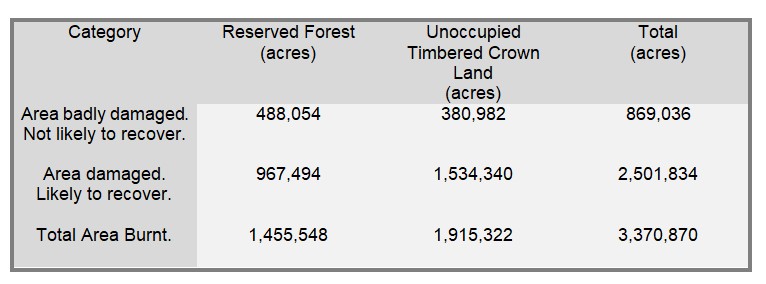
Before
Harvesting and fires had changed the age class of the Mountain Ash forest somewhat, but there were also vast areas of mature forest burnt. What did this mature forest look like before the fires?The following information provides a good picture of the size of the mature forest, as do Figures 1 to 5
"Height - Fairly complete information with regard to maximum heights attained by this species is given in articles by AD Hardy, published in the Gum Tree in 1921 and 1927. The greatest height authentically quoted is 320 ft. 1 in., which was the measured height of a tree found on a spur of Mt. Baw Baw, Gippsland (91 miles from Melbourne). Trees with heights of up to 375 feet are quoted on what appears to he reliable authority, but unfortunately those trees are now destroyed and actual certainty as regards their height must remain a matter for conjecture. A tree which is standing at the present time in the Cumberland Valley, about 14 miles from Marysville, has a height of 301 ft. 6 in. While it is possible that a close inspection of this region may mean the discovery of trees of somewhat greater height, it appears unlikely that anything surpassing 326 feet will now he found. At the same time, the fact that trees of much greater height once existed appears unquestionable." 9
"The following are measured heights of (9) trees still existing in the Cumberland valley on one sample acre."... "This acre plot carries 27 trees with an average total height of 266 feet." 9
"Generally speaking, the height of trees in virgin stands falls below the maximum already given. Reference to Graph 1, which was compiled during the preparation of Mountain Ash volume tables in Erica District, giving average heights for 2-ft. girth classes in virgin stands, indicates that the average height of mature Mountain Ash in virgin stands varies between 180 feet and 240 feet." 9

Major fires in the areas of Noojee and Erica in 1926 and 1932 had killed significant areas of mature Mountain Ash forest. As mentioned above, following 1939 there was concern that any of these areas that had been burnt again would fail to regenerate. Similar concerns were held for areas that had been harvested prior to the fires. There were, however, areas that had regenerated following the fires in both 1926 and 1932 that survived the 1939 fires. They showed up in the extensive mapping of these regrowth forests that occurred throughout the 1960's and possibly into the 1970's.
1926 Fires
"Throughout February and March 1926, forest fires raged across large areas of Gippsland. In total, 60 people died. There was widespread destruction to farms, houses and sawmills. It is estimated 400,000 hectares of forest were burnt. The fires reached their peak on 14 February (Black Sunday) when 31 people died at Warburton near Melbourne. Other areas badly affected include Noojee, Kinglake, Erica and the Dandenong Ranges." 12
"Bush fires at the Brown Coalmine Township (now Yallourn North - Ed) and Yallourn caused considerable damage yesterday. For a time both townships were in danger, and the brown coalmine is still menaced. A fire ignited the coal face in the new opencut, and the coal is still burning. Damage to machinery at Yallourn is estimated at nearly £40,000. Several fresh outbreaks of fire occurred in the area between Moe and Walhalla and Fumina and Erica. Walhalla for a time was menaced, but is now believed to be safe. Fires which have burnt across the country to the east of Gould (now under the Moondarra Reservoir - Ed), Erica, and Knott’s siding on the railway line from Moe to Walhalla, and south from Walhalla have caused grave concern in the last few days although their progress towards the Brown Coal Mine and Yallourn has been less rapid since the weekend owing to the absence of wind." 11
"The total number of outbreaks recorded was 426 which affected 478,000 acres of Reserved forest and 498,000 acres of Crown Lands. 145,000 acres of the Reserved forest and 62,000 acres of Crown Lands were badly damaged." 3
In the North-eastern districts, the Yarra Valley, the Neerim and Erica districts, the reported losses were heavy, but subsequent surveys by officers of the staff reveal the fact that the losses, though great, were over-estimated in early reports. By prompt action in several areas, particularly in the mountain ash country, the timber at first thought ruined will be utilized and will find its way into commercial use." 3
1932 Fires
"Following normal spring weather, a hot dry period, commencing just before Christmas, was experienced during which practically no rain was recorded throughout the State and hot northerly winds were of frequent occurrence. The culminating point was reached during the night of 4th February, when a fierce northerly gale of terrific intensity caused fires to develop and spread with extraordinary rapidity, so much so that it would have been impossible to check them by any human agency. During the morning of the following day, a providential change in direction of the wind, accompanied by heavy rains, occurred, otherwise the destruction must have been even much more serious than was actually the case. An extraordinary feature of these fires was the unusual fierceness with which they burned during the night, a phenomenon very rarely known." 4
"Unfortunately, the fires were responsible for regrettable loss of life in addition to causing enormous damage to valuable forest areas and private property. The majority of the damage occurred between 21st December and 6th February. corresponding to the incidence of the hot, dry spell referred to. During this period, 179 out of a total of 230 fires which damaged State Forest during the year occurred, with consequent damage estimated at over £40,000 to 186,000 acres of State Forest, exclusive of damage done to unreserved Crown lands". 4
After
As set out above, apart from the enormous impact on future timber supplies with the death of most of the mature Mountain Ash forest, there was great concern about extensive areas that might not regenerate. Figures 6-14 illustrate the severity of the fires in the areas that would be salvaged.
"A very serious aftermath of the fires, .... was the wholesale destruction of immature regrowth stands. .... Their potential value as sawmilling units of the future was enormous, however. Although the average age of these stands was approximately 10-15 years, their destruction actually represents a loss of considerably more than this period of growth. .... a considerable proportion of the areas carrying these regrowth stands are not expected to regenerate naturally, and artificial reforestation will be a prolonged and expensive operation. Actually such reforestation measures on an extensive scale must be held in abeyance pending the elaboration of fire protection plans for these areas, and the results of initial experimental investigation to determine a satisfactory afforestation technique.” 5
"Perhaps the most serious aspect of the destruction of the immature stands in the mountain forests is the prospect of failure of natural regeneration due to lack of seed trees. A considerable proportion of the areas affected carried seedling regrowth which resulted from previous fires, notably those of the 1926 and 1932 summers. Most of the seed trees on those areas were killed by these previous fires, with the result that over extensive areas none of the old seed trees are alive, and at the same time the regrowth had not reached the seed production stage." 5
“The survey showed that, in the districts mentioned, over a total area of approximately 73,000 acres natural seedling reproduction cannot reasonably be expected." 5
Regenerating
The silvicultural system in place in Mountain Ash forests at that time was based on the retention of seed trees, and it seems some Spring burning was done at times to reduce the level of hazard presented by logging slash.
"With the above considerations in view, the silvicultural system adopted in Mountain Ash country in Victoria is clear felling with the retention of seed trees. The provision of seed trees is considered essential as an insurance against subsequent damage of the regrowth before it reaches the stage when it bears fertile seed, and also to provide seed should there be no seed year immediately following exploitation fellings in the old crop. There is at present insufficient data on which to determine the optimum number of seed trees to be left, but as a provisional measure not less than four well-distributed trees are retained per acre." 9
The FCV also had a strong focus on returning forest to those areas where natural regeneration was in doubt.
"The desirability of reafforesting such very valuable timber producing land was recognized by the Commission, and investigations were carried out over a number of years to determine the practicability of re-establishing the native hardwood crop by broadcast sowing of seed. Little success attended these efforts and, following the fires of 1939, it was decided to conduct intensive experimental work in connection with the planting of nursery propagated hardwoods." 2
"Accordingly, a nursery was established at Loch Valley, a few miles north of Noojee, where Mountain Ash seedlings were raised by "tubing" and planted out. It was definitely proved that this species can be successfully re-established by this method." 2
Frank Smith managed this program at Loch Valley from September 1942, and an illustration of the work can be found in this newspaper article, which indicates that large numbers of Moutain Ash seedlings were being raised. (Figure 15)
The uncertainty about regeneration on some areas meant that considerable planting was undertaken, and there are photos of planting that had occurred on the Toorongo Plateau by the FCV (Figures 18 & 19), and near Fernshaw (Figures 16 & 17) by the Melbourne Metropolitan Board of Works. The planting rows at Fernshaw, to the right as you drove up the Black Spur, could still be discerned until at least into the late 1980's. The scale of the planting that was done is unknown at this stage.
History has shown, of course, that natural regeneration in the mature stands that were burnt was generally rapid and effective.
The Plan
Albert Lind, then the Minister of Forests and Lands, made a speech to Parliament 10 on the 4th of July 1939 in which he outlined the initial plan to salvage timber from the fire-affected areas. Interestingly, given the dramatic change in attitude and culture within the FCV towards its fire responsibilities that was initiated by the Stretton Royal Commission, the Minister was critical of the Commissioner's Report.
The most important forest type, from the point of view of timber supplies, that was burnt in the 1939 fires was Mountain Ash (Eucalyptus regnans). The vast majority of this forest type was burnt and much of it was mature forest.
"With figures of previous assessment surveys in these stands available as a basis for computation, it was estimated that in the areas in question the log volume of timber killed amounted to 2,070,000,000 superficial feet, of which it would be economically practicable to salvage 916,000,000 superficial feet, the remainder being irrecoverable due to wind and fire damage or to inaccessibility.” 5
"The Government has already begun the work, in as much as it has provided a sum of 46,000 pounds (about $3.8 million in 2020) out of unemployment relief loan money for the construction of tracks, trams, and other facilities, to make it possible for millers to operate in the area concerned." 10
"It is proposed that all of this timber should be treated in two years,in the following manner: 10
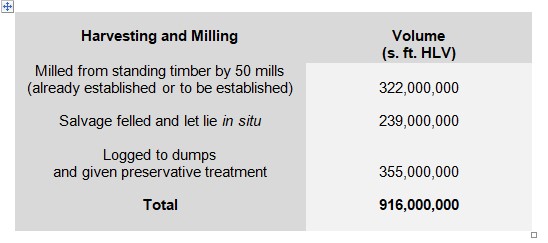
- The total expenditure required to cover the cost of salvage operations, whether done by way of advance to sawmillers or directly by the Commission, is estimated to be 468000 pounds (about 38 million in 2020) .... that is the amount provided for in the bill.
- Provision is made that advances to sawmillers may be made on terms as to repayment to be determined by the Forests Commission, with the approval of the Treasurer.
- It is proposed that repayment of the advances made to sawmillers shall be effected by means of a surcharge on the sawn timber produced by the Miller from the salvaged logs.
Although the original plan was based around a period of two years in which salvage would be possible before the timber deteriorated to an extent that it was unusable, experience quickly showed that:
"The original plans were based on an estimated life of two years for timber in the standing tree, and it is satisfactory to report that, contrary to opinions formed immediately after fires, the standing timber is now considered likely to remain in sound condition for longer than the original estimate." 6
Salvage areas focused on access from Noojee, Tanjil Bren and Erica, as well Toolangi, the Otways and the Rubicon valley. In today's terms the salvage of 916 million s.ft hlv equates to about 2.75 million m3.
Harvesting
Galbraith9 describes in some detail the harvesting systems that were being used in the fire-killed forests before the 1939 fires. The main system was cable logging, which was increasingly being augmented by the use of crawler tractors which came into use in Victorian forests about 1934. Those systems would continue to form the core of the harvesting methods in the salvage operations. Figures 20 to 30
Some of the earliest salvage harvesting centred on Tanjil Bren.
"The second initiative was the granting in 1940-41 of quota allocations to eleven companies to log and mill the stands of timber centred on Tanjil Bren, some 40 kilometres from Noojee and extending eastwards to the slopes of Mt Baw Baw. At the same time, sawmills at Erica were also processing fire-killed ash from areas which had previously undergone logging." 1
"Later in the 1940's the mainstream of the logging operations shifted to Toorongo, the Upper Thompson and Matlock. Mills were established at these locations but logs were also carted to Noojee." 1
About one year after the fires the FCV had started to use the extra funding provided by Government to initiate additional harvesting operations in the salvage area.
The Commission entered into agreements with fourteen sawmillers to finance up to 90% of the cost of timber salvage operations carried out by them. These agreements provide for the logging of 294,000,000 superficial feet. Several millers have carried out salvage felling at their own expense, while a number of others, who were not required to undertake salvage felling, have obtained their mill log supplies exclusively from fire-killed timber. In addition, the Commission let contracts for the salvage of 67,000,000 superficial feet of logs into dumps." 6
Not only mature trees were salvaged. Market conditions allowed some fire-killed regrowth stands to be salvaged as well.
"An important feature of salvage operations has been the recovery and marketing of large quantities of timber from small-sized Mountain Ash and Alpine Ash trees, the loss of which from a State forestry standpoint constituted one of the most regrettable features of the 1939 fires, as these young stands represented the growing crop to replace the older forests being harvested. Under normal circumstances, only very small quantities of this timber would have been recoverable except as pulpwood, but a reduction in imports of softwood case timbers due to war conditions focussed the attention of case manufacturers on the necessity for a more extensive use of native hardwoods for case making. For this purpose, young Ash timber has proved very satisfactory, even for the manufacture of high quality export packs for which it has been accepted by the Commerce Department. Much of Victoria's primary produce, such as butter, eggs, dried fruit and cheese, will this year be exported in attractive boxes made from young fire-killed Victorian timber." 6
Storing and Preserving
After the 1983 Ash Wednesday fires killed extensive areas of Pinus radiata near Mt Gambier, the salvage program involved the construction of dams to store logs, and preserve them, until they could be processed. The 1939 salvage program followed the same principle - keep the logs as moist as possible until they could be transported to a sawmill. Logs were dumped in drainage lines, water offtakes were built to allow water sprays to be used at dumps and one large dam was built for log storage although, as you will read below, it failed before becoming useful.
"One of the areas ravaged by the fires was the ash forest to the east of Noojee and extending to Mount Erica. Unlike the mixed species timbers of the foothills, the ash eucalypts cannot withstand a burn of the magnitude of the 1939 fires. Therefore, it became imperative that the fire-killed trees be harvested for timber before they deteriorated through weather and insect attack." 1
"Two initiatives were undertaken to enable the fire-killed trees in the forests of Tanjil Bren to be processed before weathering and insects rendered them fit only for pulpwood. The first was salvage falling. This involved falling best quality trees which were then cut into long lengths and the ends coated with a preservative emulsion. These were allowed to lie on the ground where they were soon sheltered by an undergrowth of ash regeneration and scrub which grew profusely following the fires. The extent to which this could be done was limited for practical reasons but it did work very well. These fallen trees were in excellent condition, with few cracks, and sapwood which was damp, soft and easy to saw." 1
"The CSIRO’s advice had been to keep the logs wet with water sprays but, on a long straight stretch of Mundic Creek, something better was attempted. A large timber dam was built across the creek by Forests Commission engineer, Phillip Avery. The dam was of massive crib-log construction, with the upstream side faced with heavy planking. However, not long after its completion, a violent storm on the Toorongo Plateau filled Mundic Creek to overflowing; the planking failed and the dam burst. It was not repaired and, consequently, the dump remained only partially submerged." 8
Mundic Dam appears in Figures 31-37, and you will see that evidence of the dam was still in place in 2011. Log dumps, water take-offs, and dumps with sprays are illustrated in Figures 38-43.
Transporting & Converting
Before 1939, tramlines were the main method used to move logs from dumps and landings into sawmills which were most frequently located inside the forest boundary. Post-1939 road transport became increasingly important, requiring new roads to be built into areas that had not been accessed previously. Old tramlines destroyed by the fires were rebuilt and new ones constructed to help move salvaged timber. An indication of the scale of harvesting at some times, and the movement of wood out of places like the Thomson Valley and the Toorongo Plateau, can be seen by the following: Figures. 51, 52, 53
"One day my siblings and I counted about 100 log trucks going past our house in Loch Valley. (Roger Smith)"
Roger lived in a new (and very small) FCV residence in Loch Valley from 1942 to 1948. His father, Frank, as you will see earlier in this article, was responsible for the nursery raising eucalypt seedlings to plant on the Toorongo plateau and elsewhere.
The FCV had a major program to provide access to the stands that were to be salvaged. Figure 54
"Almost the whole of the area carrying fire-killed timber is rugged and mountainous and at the time of the fires was devoid of any means of access. Accordingly, the construction of more than 40 miles of roads and steel tramways by the Commission was planned to permit the entry of heavy logging and milling machinery, and the extraction of sawn timber and logs." 6
and, by the end of the 1939/40 financial year;
"The construction of 21¾ miles of roads and 10½ miles of 3-foot gauge steel tramline has been completed by the Commission. In addition, 5¾ miles of road and 3 miles of tramline are under construction and surveys are in progress for further extensions of access facilities. " 6
Jack Gillespie who finished his working life in the FCV as the Divisional Forester in Horsham, but from 1951 to 1953 was the District Forester at Erica, wrote an article in the VSFA Newsletter of June 1967 about salvage in the Thomson Valley. Selected quotes from his article are provided below. Figures 45 to 48
"When the mountain forests were killed by the fire and salvage operations were planned it was decided that access into the Thomson Valley areas was to be achieved by extending the already existing tramline. Thus it came about that Ezards extended their line across the South Cascade Creek to Rocky Knob and the Commission constructed a further 61⁄2 miles of tramline to Bells Creek watershed. Joint use of the greater part of this tramline continued from about 1941 to 1949 when the line was closed. Tramline operation continued in this district long after other major sawmilling areas had switched almost entirely to road transport." 13
"In addition to this the single track carried a number of scooters of varying design used to transport employees of the millers or the Forests Commission." 13
"Possibly the most spectacular engineering feat of this line was the bridge over the South Cascade Creek, built by Ezard's bush crew. The height from the water to the rails was over 90 feet and the bridge was curved." 13
Two of the FCV's tractors that were used on the Thomson Valley Tramway are shown in Figures 49 & 50
"The Thomson Valley Tramway ceased operating in 1950 when, following the refusal of the FCV to purchase his section, Ezard dismantled the line from Rocky Knob back to Erica leaving the Commission's section isolated. Two of the FCV rail tractors, a WD 40 and a Days-McCormack Deering, were left at Bells Creek and Rocky Knob for use in case of fire while the Thomson Valley Road was extended through to Bell's Creek. The tractors remained there until the late 1970s, the Days-McCormack Deering now on display at the Erica Recreation Reserve." (Extract from the sign accompanying the recovered Days-McCormack Deering tractor.)
Arrangements to process the salvaged timber had to be made. Figures 55 to 57
"The recovery of the maximum amount of timber by direct milling was to be achieved by encouraging private enterprise to establish sawmills in the burnt areas. Provision was accordingly made for the establishment of 50 mills capable of utilizing 322,000,000 superficial feet of logs from standing timber over a period of two years." 6
And, by the end of the 1939/40 financial year;
"Forty-eight bush sawmills are already operating on fire-killed timber, and a number of others are under construction. 96,000,000 superficial feet of logs were utilized by these mills, many of which operated for only a short period in the past financial year. Further areas were allotted for milling as road or tram construction rendered them accessible." 6
The Numbers
The original salvage target for sawlogs was 916,000,000 s.ft hlv over a couple of years. However, sawlog (and pulpwood) salvage was still being recorded in FCV Annual Reports until the mid-1950's, by which time there was concern about the negative impact of harvesting on regeneration.
The final sawlog volume salvaged was about 1,434 million s.ft hlv.
"At the close of the financial year, the total quantity of fire-killed timber which had been utilized was 1,434,355,439 superficial feet, Hoppus log volume, against an estimated recoverable volume of 916 million superficial feet. In view of the fact that operators are finding it necessary to push further back into valuable stands of advanced regrowth, greater restrictions must necessarily be imposed in regard to the selection of areas on which utilization can still be allowed. In most cases deterioration of the dead timber has reached a stage where its utilizable value could not justify the damage which its extraction would cause to the regrowth." 7
In today's terms the original salvage target for sawlogs was about 2.75 million m3 . The volume actually harvested was about 4.3 million m3 , 56% more than planned.
Sources
2. Evidence to the Rural Reconstruction Commission. FCV (1943)
3. FCV Annual Report 1925/26
4. FCV Annual Report 1931/32
5. FCV Annual Report 1938/39
6. FCV Annual Report 1939/40
7. FCV Annual Report 1954/55
9. Mountain Ash - a general treatise on its silviculture, management and utilisation. Galbraith AV, 1937
10. Speech-State Forests (Timber Salvage) Loan and Application Bill, July 1939
11. The Argus, Feb 18, 1926
12. The Australian Institute for Disaster Resilience
13. VSFA Newsletter No. 22 p6
See Also
The Hand of Man - FCV.
The gallery on this page. It includes all photos in this article
Trestle Bridges and Tramways. The timber industry of Erica district 1910-1950. Mike McCarthy, 1983. (Some photos appear in this article.)
Victorian Year Book 1938-39 (Extract)
Note: Sawlog volumes, unless otherwise indicated, are given in Super Feet, Hoppus Log Volume (s.ft hlv). One s.ft hlv is 78.5% of one s.ft true measure.

